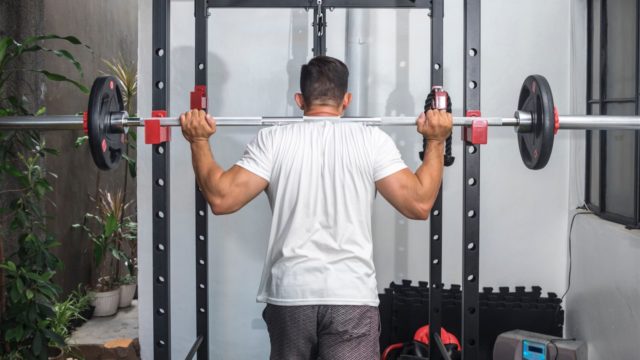
Whether you’re setting up your own home gym or simply trying to figure out where to settle in for your next exercise at the neighborhood fitness center, you’ll likely be confronted with the choice between a squat stand and a power rack.
Squat stands consist of two simple metal uprights to support a barbell — they are more compact and significantly lighter than power racks. A power rack, sometimes referred to as a squat rack, will typically have four to six metal uprights and offer more exercise options and accessories than a pair of squat stands.

While these two pieces of equipment are often used interchangeably, differences in their characteristics and intended usages are worth consideration. This article will help you make the most out of your home gym budget or your commercial gym workout by guiding you to the most appropriate and safest piece of equipment for your specific needs.
Squat Stand vs. Power Rack
Differences Between Squat Stands and Power Racks
At first glance, squat stands and power racks differ substantially in physical size — squat stands are smaller and power racks are bigger. Comparison done and dusted, right? Nope, not so fast. Differences in safety features, mobility, stability,potential exercises, and accessories are worthy of consideration.
Safety Features
A spotter is a trained and capable individual whose primary task is to ensure the safety of the lifter by assisting when necessary. One or more spotters are recommended for traditional strength training exercises when a barbell is held on the back or front of the body, when weight is lifted overhead, or when a weight travels over the face. (1) Under these guidelines, many common barbell exercises require the presence of a spotter — back squat, front squat, overhead press, bench press, incline press, and more.
No one wants to get pinned under a barbell, asphyxiate with a bar atop their windpipe, or catch a barbell to the face. Albeit unlikely, serious injuries or even death could occur if you train without appropriate safety precautions. But if you train alone or at home, you might not always have a trained spotter available. Now what?
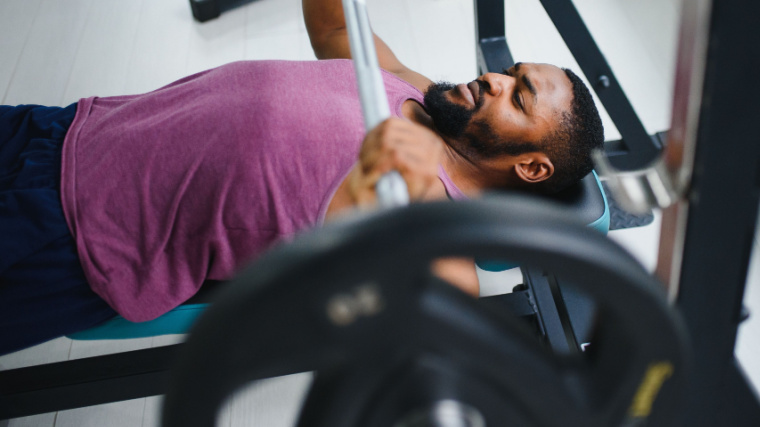

Fortunately, a power rack, when properly set up and appropriately used, provides safety pins/pipes, arms, or straps that “catch” the barbell in the event of a failed lift. (2) Traditional squat stands, on the other hand, do not offer safety arms — even among squat stands that offer safety arms, the stability of the stands varies widely across designs and manufacturers.
Some heavy-duty squat stands with safety arms are appropriate to handle the failed lifts of all but the strongest lifters, while lighter and smaller squat stands with safety arms might not be trusted. Altogether, lifters who train alone might benefit from the safety features of a power rack.
Mobility
A key feature of squat stands is their mobility, or ability to be relocated from place to place. Traditionally, squat stands were used by Olympic weightlifters. Relatively lightweight squat stands could be carried or wheeled onto the platform for use then pushed back against a wall or into a corner when no longer needed.
To further improve mobility, some squat stands have two-piece designs. Each upright has its own base, allowing it to be moved and positioned independently of the other. One piece squat stands commonly include or have the option of adding wheel kits, which allow the stand to be rolled around the gym with relative ease.
For individuals with a garage gym, the mobility of a squat stand may allow it to be stowed away when not in use, possibly allowing the garage to serve its original purpose — vehicle storage. Better yet, on a nice day, a squat stand might be moved outdoors. Sun’s out, guns out, right?
Stability
Power racks are typically more difficult to move around than squat stands. They tend to be big and heavy, with lighter power racks typically designed to be bolted to the floor.
Most importantly, power racks tend to have a longer base of support, or footprint. This allows the lifter to perform squats, bench presses, and other exercises within the rack. Lifters tend to feel more “secure” when performing barbell exercises within a power rack — and for a good reason.
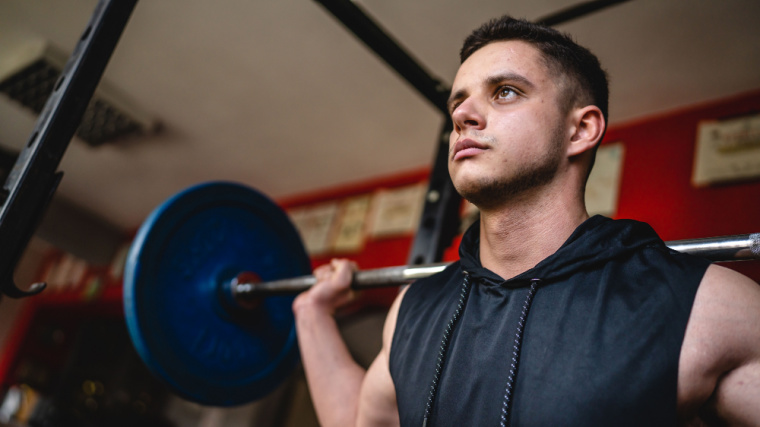

All exercise in the power rack is performed over the rack’s base of support, which allows effective use of the safety features. A missed lift is almost assuredly “caught” by the safeties and the rack won’t tip over. Moreover, the larger base of support, paired with the larger mass of the power rack, makes it less prone to tipping or moving while in use.
Note: The half rack is a design variant of the power rack. Half racks consist of two uprights in front, to support the barbell, and two additional uprights in back, which enhance the stability of the rack above and beyond the two-post squat stand design. While performing common barbell exercises in a half rack, the lifter remains over the rack’s base of support owing to the elongated base of the rack.
Accessories and Exercise Options
More space and more stability offer the ability to deck out power racks with accessories. In addition to safety equipment such as spotter arms, pins/pipes, or straps, power rack can offer attachments for additional exercises and equipment storage.
While taller squat stand designs may offer the option of a pull-up bar, multi-grip pull-up bars are routinely mounted on power racks. Multi-grip pull-up bars allow for traditional pull-ups, chin-ups, neutral-grip pull-ups, and more. Many power racks are compatible with rack-mounted dip bars and medicine ball targets. Attachments may also be affixed to the bases or uprights of power racks to perform a variety of landmine exercises.
Heavier power racks or those bolted to the floor may accommodate band pegs, which allow for band-resisted or band-assisted barbell movements. Plates may be stored on posts, which are bolted or welded to the rearmost uprights of a six-post power rack or a half rack. Simple storage solutions, such as hooks, bands, chains, belts, and barbells, mounted to the sides of power racks or half racks. If you value customization and exercise variety, a power rack is a strong choice.
Similarities Between Squat Stands and Power Racks
Although certainly not interchangeable, squat stands and power racks provide similar benefits and uses.
Support for the Barbell
Many common exercises, including squats and presses, benefit from an elevated starting position for the barbell. Before squat stands and power racks, squatters had to clean the barbell to their shoulders or perform an outlandish maneuver of tipping the barbell on end in an attempt to get under it.
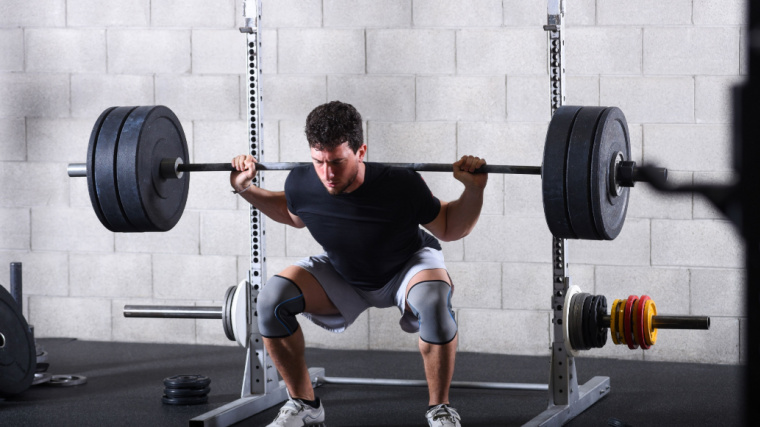

Think about how much energy was expended prior to starting the actual set. Squat stands and power racks allow the lifter to conveniently retrieve the barbell when setting up and finishing various lifts.
Accommodate Lifters of Various Sizes
Squat stands range in height from just over four feet to well over nine feet, while power racks tend to range from six feet to 10 feet. The start position of the barbell is adjustable in increments to allow fine-tuned position of the J-hooks (the specialized attachment used to support the barbell on the rack).
This adaptive setup allows trainees to customize starting positions to their height for more efficient training, which can be necessary for taller lifters as well as lifters of shorter stature.
Allow a Variety of Exercises
Squat stands and power racks are versatile. Both pieces allow lifters to perform barbell squat variations, including, but not limited to back squats, front squats, Zercher squats, and safety squat bar squats. Additionally, power racks and very sturdy squat stands can be used to support the barbell in an elevated position to avoid having to deadlift from the floor (i.e. rack pull deadlifts) or avoid having to lift the bar from the floor to the start position of exercises such as bent-over rows, wide rows, and Romanian deadlifts.
Many other exercise options may be possible with other accessories. For example, add an adjustable weight bench and lifters can perform the bench press, incline press, and seated overhead press. Exercise options for squat stands and power racks are discussed at length later in the article.
How to Use Squat Stands
- Ensure your squat stands are appropriately placed. Squat stands should sit on level ground. Independent or two-piece squat stands must be placed an appropriate distance apart — stands should be set narrower than the distance between the sleeves of the barbell. Placing the stands four to six inches narrower than the inside distance between the sleeves reduces the likelihood of bumping or knocking over the stands when re-racking the barbell.
- Set the height of the stand or J-hooks. The J-hooks should be placed one setting below or one to three inches below the anticipated start height of the exercise. Appropriately placed J-hooks allow the lifter to remove the barbell from the rack with minimal vertical displacement and minimal disruption to body position. For example, the height of the J-hooks should require the lifter to slightly flex their knees and hips to place the bar on the upper back when setting up for a back squat. (3)
- Load the barbell, recruit a spotter if necessary, and perform your set. Recall, at least one spotter is recommended for traditional strength exercises when a barbell is on the back or front of the body, when lifted overhead, or lifted over the face. (1)
- Re-rack with care. Depending on the stability of the squat stand, a degree of caution is indicated when replacing the barbell on the squat stands. Aggressively driving the barbell into the J-hooks or carelessly bumping the stands may cause undesirable movement of your equipment at the worst possible time — when you’re fatigued at the end of the set.
How to Use Power Racks
- Set the height of the J-hooks. Hooks should be placed one setting below or one to three inches below the anticipated start height of the exercise. Once again, appropriately placed J-hooks allow the lifter to remove the barbell from the rack with minimal vertical displacement and minimal disruption to body position. For example, the height of the J-hooks should allow a lifter performing a bench press to slide the barbell forward out of J-hooks with their elbows straight, but without losing upper back tension or requiring forward movement of their shoulder blades.
- Set the height of the spotter arms, pipes, or straps. The safety arms should be placed one setting below, or two to four inches below, the anticipated lowest depth of the exercise. (2)
- Load the barbell, take note of hand placement, and perform your set. Take note of your hand placement on the bar during setup. Those who squat or press with excessively wide hand placement may be at risk of pinching their hands or fingers between the barbell and the power rack. If your mobility does not allow you to take a narrower grip, be aware that quick movement of your hands may be required to prevent pinching during re-racking or in the event of a failed lift. (2)
- Return the barbell to the rack. Return the barbell to the power rack by first pushing the bar against the vertical back surface of the J-hook. Once you feel, hear, and see the barbell make contact with both J-hooks, control the bar until it comes to rest.
When to Use Squat Stands or a Power Rack
As indicated by their long history of use in Olympic Weightlifting, squat stands can be appropriate for certain types of exercise and convenient for exercise in novel locations. However, beefy power racks are a mainstay in strength training facilities across professional and Olympic sports. They’re a key piece of equipment for a wide variety of exercises.
For Power-Focused Exercises
“Power exercises” refer to lifts performed with ballistic intent — not to be confused with powerlifting exercises (i.e, the squat, bench press, and deadlift). Power exercises include Olympic weightlifting movements (i.e., clean & jerk, snatch), weightlifting derivatives, and loaded jumps. A spotter is typically not recommended for power exercises, as the individual may get in the way of the fast lift or worse yet, become injured by the rapidly moving barbell.
Certain barbell-based power exercises benefit from the convenience of a squat stand but might be inappropriate to be performed in a power rack. Exercises like jerks, push presses, and squat jumps are more appropriately performed outside of the power rack or several feet away from a squat stand.
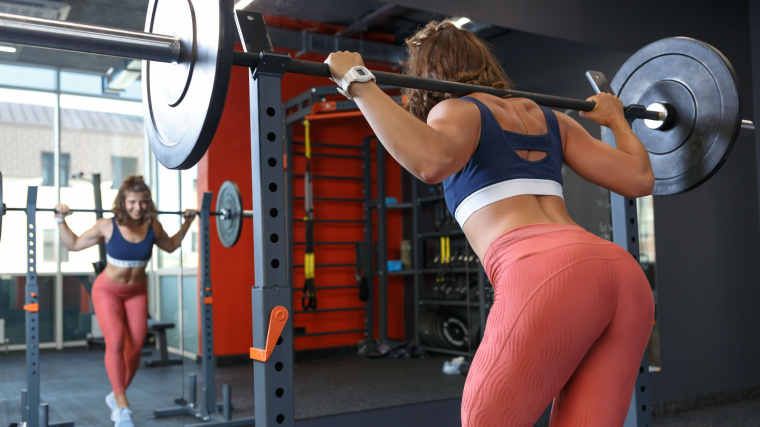

Using a squat stand allows the lifter to efficiently load the barbell and set up jerks, push presses, and squat jumps, then step away from the rack. In the event failure occurs during power-based exercises, the lifter must know how to safely “bail,” or get out from underneath the barbell. (2) Bailing may entail either pushing the barbell forward and simultaneously jumping back or throwing the barbell backward and leaping forward out of its path. (2)
It’s best not to be “trapped” in a power rack if bailing is necessary. In the event a lifter is forced to bail during a power exercise, clear surroundings are essential with no other persons, and minimal equipment, in the immediate area. Loading the bar with bumper plates is preferred to promote equipment longevity. (4)
For Technique Work
While squat stands do not tend to be as stable or offer the safety features of power racks, they should be sufficient for handling relatively lighter sets of traditional barbell exercises and sets ended far from muscular failure. Essentially, these sets can be classified as “technique work.”
Technique work is appreciated as an opportunity to stimulate improvements in coordination and foster long-term athletic development. Squat stands allow you to efficiently set up barbell exercises and put in the reps while maintaining total control over the bar, even at the end of a set.
For Outdoor Workouts
“Suns out, guns out,” remember? Few things are better than training outside on a beautiful day. Mobile squat stands allow traditional barbell exercise to be performed in non-traditional environments. Simply haul or roll your squat stand to level and firm ground, set up, and train while simultaneously topping up your vitamin D levels.
For Heavy, High-Effort Lifting
Heavy lifting is performed with high loads (i.e., 85% or more of one’s maximum), while high level of effort lifting describes sets approaching failure. Although neither heavy lifting nor high-effort lifting are inherently dangerous, both present an elevated risk of failure.
In the event that failure is reached during a barbell squat or press, you’re going to want the secure frame of a steel power rack to protect you. Appropriately placed safety pins/pipes, arms, or straps on a power rack should provide the confidence to push through the hardest sets.
For Accessory Exercises
While commercial gym etiquette may declare “no curling in the squat rack,” power racks do allow for a wide variety of accessory exercises. Most power racks come equipped with a pull-up bar, which allows for a variety of pull-up variations.
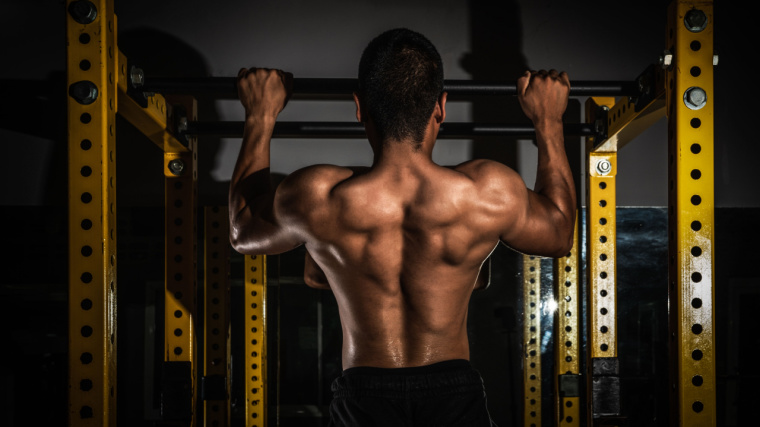

Unlike taller squat stands, which might also offer a pull-up bar, the stability of an appropriately installed power rack may allow for kipping exercises, such as toes-to-bar or muscle-ups. Power racks can be used to set up rack pull deadlifts and barbell shrugs.
For Pin Pressing and Pin Squatting
Pin presses and pin squats begin with the barbell setting on the safety pins/pipes of a power rack in the lowest position of the exercise. Each repetition begins and ends with the barbell coming to a dead stop on the pins/pipes. Pin presses and pin squats eliminate the stretch reflex at the bottom of traditional pressing and squatting exercises.
Ultimately, pin presses and pin squats tend to require less weight to achieve a stimulating training effect, and may help to improve “starting strength,” or the ability to overcome the inertia of a load at rest.
The Centerpiece of the Gym
Squat stands and power racks are key pieces of gym equipment for athletes, bodybuilders, and fitness enthusiasts alike. But just as you wouldn’t use a hammer to drive a screw, selecting the right tool for the job is essential for safe and effective training.
References
- Haff, G. G., & Triplett, N. T. (Eds.). (2015). Essentials of Strength Training and Conditioning 4th ed. Human Kinetics. Champagne, IL, USA. 351-408.
- Garhammer, J. (1991). Weightroom safety: Using a power rack for squatting. Strength & Conditioning Journal, 13(5), 74-82.
- Ronai, P., & Gendron, K. (2023). The barbell back squat exercise. ACSM’s Health & Fitness Journal, 27(4), 65-73.
- Waller, M., & Townsend, R. (2007). The front squat and its variations. Strength & Conditioning Journal, 29(6), 14-19.
Featured Image: MDV Edwards / Shutterstock






